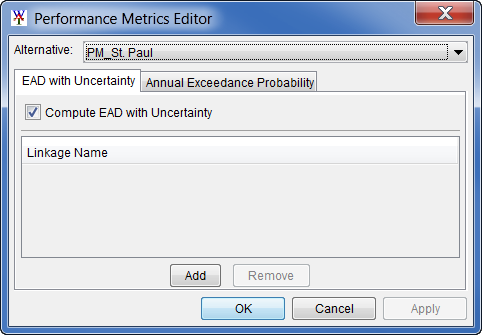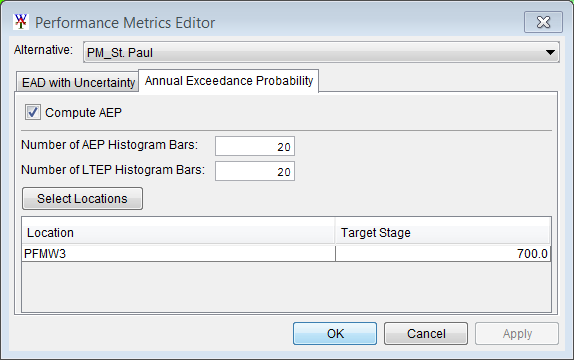Performance Metrics Alternative
For HEC-WAT to compute performance and economic metrics the user will need to create and setup certain parameters in a performance metrics alternative. This section provides information on creating, editing, saving, creating copies, renaming, and deleting performance metrics alternatives.
Create
To create a performance metrics alternative:
1.From the HEC-WAT main window (Figure 19.3), from the Study Tree, from the Models folder, right-click on Performance Metrics. From the shortcut menu (Figure 19.4), click New, or from the HEC-WAT main window (Figure 19.3), from the Edit menu, point to Performance Metrics, click New. Using either approach, the Create New Performance Metrics Alternative dialog box will open (Figure 19.5).

Figure 19.3 HEC-WAT Main Window

Figure 19.4 Study Tree – Performance Metrics – Shortcut Menu

Figure 19.5 Create New Performance Metrics Alternative Dialog Box
2. In the Name box (Figure 19.5), enter a name for the performance metrics alternative. A description for the alternative can be entered in the Description box (Figure 19.5).
3.Click OK, the Create New Performance Metrics Alternative dialog box (Figure 19.5) will close. The Performance Metrics Editor will open (Figure 19.6) and the name of the performance metrics alternative will display in the Content Pane (Figure 19.4) of the HEC-WAT main window.

Figure 19.6 Performance Metrics Editor
4.By default the Performance Metrics Editor (Figure 19.6) defaults to computing EAD with uncertainty. If the user wishes not to compute EAD with uncertainty, click Compute EAD with Uncertainty (check-mark will disappear).
5.To create a name for linking the models to the active performance metrics alternative (i.e., PM_St. Paul), click Add (Figure 19.6). A default name will display (EAD 1, EAD 2, etc.) in the Linkage Name Table (Figure 19.6). The user can change this default name by selecting a row in the table and changing the name. A name can be deleted by selecting a row, clicking Remove (Figure 19.6) and the selected name is deleted.
6.From the Annual Exceedance Probability tab (Figure 19.7) of the Performance Metrics Editor, the user can setup the computation of AEP. By default, the computation of AEP is set. If the user does not wish to calculate AEP, click Compute AEP (check-mark will disappear). It should be noted that AEP is used in the calculation of the other performance metrics (e.g., Assurance, LTEP). Therefore, ensure that AEP is being computed when also computing Assurance and/or LTEP.

Figure 19.7 Performance Metrics Editor – Annual Exceedance Probability Tab
7. To display AEP and LTEP in a histogram, the number of bars (bins) is required. By default the number of bars (bins) in the histograms is set to twenty (20). The user can change the number of bars (bins) in the Number of AEP Histogram Bars and the Number of LTEP Histogram Bars boxes (Figure 19.7).
8.Next the user needs to select the location(s) where AEP is to be computed in the study. These locations can only be CCPs that have already been defined for the study area. From the Performance Metric Editor (Figure 19.7), click Select Locations, the Selection Editor (Figure 19.8) will open. From the Available Locations box, select the location(s) where AEP is to be computed. Click Add, the selected location(s) will now appear in the Selected Locations box (Figure 19.8). Click OK, the Selection Editor will close (Figure 19.8) and the names of the selected location(s) will appear on the Performance Metrics Editor (Figure 19.7) in the table.

Figure 19.8 Selection Editor
9. For the specified location(s), the user will need to enter a target stage, from the table (Figure 19.7), under the Target Stage column.
10.Now that information has be defined for the performance metric alternative, click OK, the Performance Metrics Editor (Figure 19.7) will close.
Edit
1.From the HEC-WAT main window (Figure 19.3), from the Content Pane (Figure 19.9), right-click on a performance metrics alternative, from the shortcut menu click Edit. The Performance Metrics Editor will open (Figure 19.6).
2.From the Performance Metrics Editor, the user can edit an existing performance metrics alternative. When editing is finished, click OK, the Performance Metrics Editor will close (Figure 19.6).
Save
From the HEC-WAT main window (Figure 19.3), from the Content Pane (Figure 19.9), right-click on a performance metrics alternative, from the shortcut menu click Save. The performance metrics alternative data is saved.

Figure 19.9 Individual Performance Metrics Alternative - Content Pane- Shortcut Menu
Save As
1.From the HEC-WAT main window (Figure 19.3), from the Content Pane (Figure 19.9), right-click on a performance metrics alternative, from the shortcut menu, click Save As. The Save Performance Metrics As dialog box will open (Figure 19.10).

Figure 19.10 Save Performance Metrics As Dialog Box
2.The name of the performance metrics alternative which is being copied is displayed in the Old Name box (Figure 19.10). The user will enter a new unique name in the Name box. An optional can be provided description in the Description box (Figure 19.10).
3.Click OK, the Save Performance Metrics As dialog box will close (Figure 19.10), and the name of the new performance metrics alternative will appear in the Content Pane (Figure 19.9) of the HEC-WAT main window (Figure 19.3).
Rename
1.From the HEC-WAT main window (Figure 19.3), from the Content Pane (Figure 19.9), right-click on a performance metrics alternative, from the shortcut menu click Rename. The Rename Performance Metrics dialog box will open (Figure 19.11).
2.The name of the performance metrics alternative which is being renamed is displayed in the Name box. The user must enter a new unique name in the Name box (Figure 19.11). An optional description can be provided in the Description box (Figure 19.11).

Figure 19.11 Rename Performance Metrics Dialog Box
3.Click OK, the Rename Performance Metrics dialog box will close (Figure 19.11), and the re-named performance metrics alternative will appear in the Content Pane (Figure 19.9) of the HEC-WAT main window (Figure 19.3).
Delete
1.From the HEC-WAT main window (Figure 19.3), from the Content Pane (Figure 19.9), right-click on a performance metrics alternative, from the shortcut menu click Delete. A Confirm Delete window box will open (Figure 19.12).

Figure 19.12 Confirm Delete Window
2.Click Yes, the selected performance metrics alternative will no longer be displayed in the Content Pane (Figure 19.9) of the HEC-WAT main window (Figure 19.3).